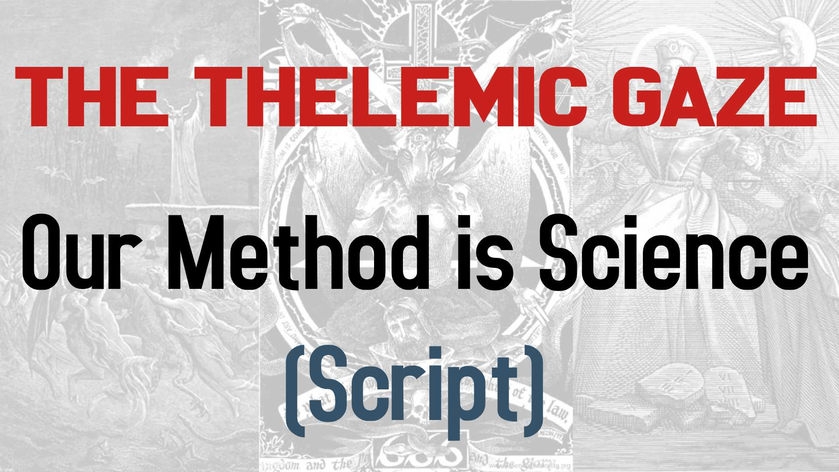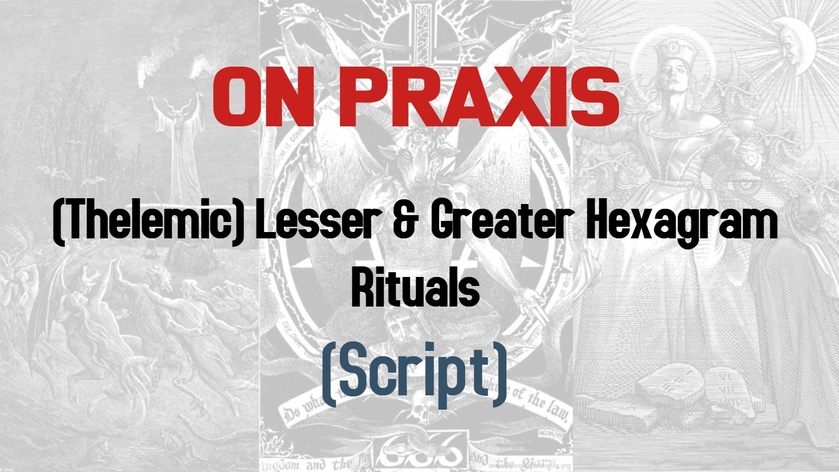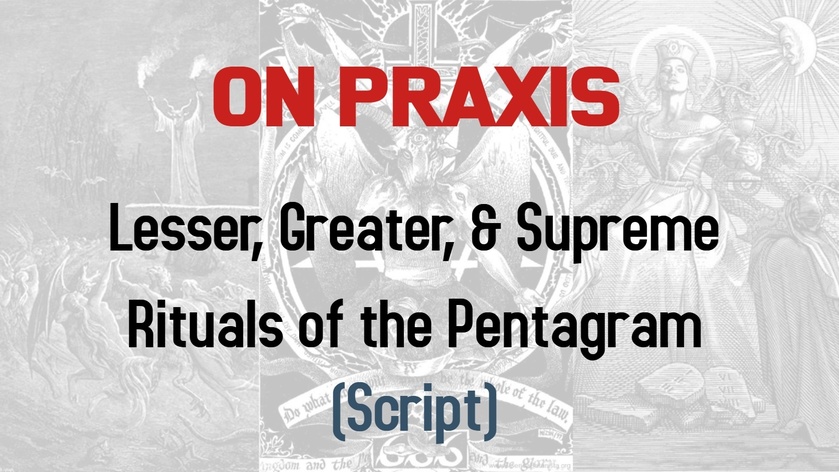Our Method is Science
The Thelemic Gaze
Do what thou wilt shall be the whole of the Law.
Thelema is a Spiritual Philosophy, more akin to Nikāya Buddhism than Christianity. Which means it can be applied to theological positions that are highly superstitious, wholly atheistic, or somewhere in-between. It should be noted that Crowley warned against dogmatically adhering to either extreme. This is likely because neither is a truly skeptical position as neither can be confirmed.
The A∴A∴ is the designated spiritual order of Thelema. One could think of it as a monastic hermetic order. Aleister Crowley gave it the motto of “We place no reliance on Virgin or pidgeon, Our method is Science, Our aim is Religion.” The occult and spiritual practices of Thelema are meant to be subjected to the Scientific Method. As this was the early 20th century, there are some minor differences between what was understood as the scientific method then and what it means today. As an example, Logical Irrelevance may not have been migrated into the Method of Science as Falsifiability in time for it to be incorporated into Crowley’s conception. However, Crowley’s dedication to the adherence of the Method of Science would mean that as the method advances so should our practice of that method.
Among the authors in the A∴A∴ Reading List is David Hume,a Scottish Philosopher known for his philosophical empiricism, skepticism, and naturalism. Among other things, he contributed to the development of the Scientific Method.
Thelema has several works which encourage skepticism, so I will finish with some discussion regarding The Book of Lies and Liber O, which were mentioned last episode.
The Method of Science
The Method of Science is not set in stone. It is a constantly evolving process. There is evidence that the Scientific Method, as we understand the term, was being utilized by the ancient Egyptians. This basic core was elaborated by the Greek philosophers, such as Aristotle or Plato. Christian theologians like Roger Bacon contributed as well. Skepticism was emphasized thanks to the contributions of people such as Francis Bacon, René Descartes, David Hume, and Galileo Galilei. The final “big name” for this list would be the alchemist Isaac Newton.
The concept of falsifiability was introduced around 1934. This principle seems to be an extension of the logical concept of irrelevance. Logically, any statement that cannot be demonstrated as false is irrelevant. Examples would include: God exists, all is Buddha Nature, or even logic is the best system. It should be noted that this is not a value judgment, merely a comment on a statements provability. It is unlikely that the concept of falsifiability was explicitly included in Crowley’s understanding of the Method of Science.
To put it simply, Falsifiability is the capacity for some proposition, statement, theory, or hypothesis to be proven wrong. This is tied to the null hypothesis. If the hypothesis of the experiment is A+B=C, then the null hypothesis would simply be A+B=!C (not-C), that is, getting any result that is not C. A common trap is to formulate the null hypothesis as A+B=-C (negative or opposite C), that is to formulate a failure as only being getting the exact opposite of result C. This is the scientific equivalent of doing a working for a million dollars and calling it a partial success because one finds a dollar on the street.
I’d like to draw attention to Newton’s contribution, as this would have been in Crowley’s conception. It is a bit difficult to follow due to its archaic syntax, but I will follow with my take after reading his list.
We are to admit no more causes of natural things than such as are both true and sufficient to explain their appearances.
Therefore to the same natural effects we must, as far as possible, assign the same causes.
The qualities of bodies, which admit neither intension nor remission of degrees, and which are found to belong to all bodies within the reach of our experiments, are to be esteemed the universal qualities of all bodies whatsoever.
In experimental philosophy we are to look upon propositions collected by general induction from phænomena as accurately or very nearly true, notwithstanding any contrary hypotheses that may be imagined, until such time as other phænomena occur, by which they may either be made more accurate, or liable to exceptions.
To explain all nature is too difficult a task for any one man or even for any one age. 'Tis much better to do a little with certainty, and leave the rest for others that come after you, than to explain all things.
These are all straight forward, but the codification brings about a uniformity — i.e. we can assume that person A is doing the same as person B if they both claim to be following Newton’s steps. Likewise, two scientists from the same time period would be using the same steps in their Scientific Method. We can infer that Newton used Occam’s razor (principle 1), consistently applied cause and effects (principle 2 & 3), trusted that what he observed was correct & that he continued to observe in order to refine his understanding until he found something that disproved his hypothesis (principle 4), and that he tried to focus on one thing at a time (principle 5). This last point is important as the more items a hypothesis tries to cover, the more complex it becomes. The more complex the hypothesis, the harder it becomes to prove or disprove it. Many a charlatan has couched their lies or hidden their failures in unnecessary levels of complexity.
The current, as of 2022, Method of Science involves the following eight steps:
Define a question
Gather information and resources (i.e., observe)
Form an explanatory hypothesis (which includes the null hypothesis &/or falsifiability)
Test the hypothesis by performing an experiment and collecting data in a reproducible manner
Analyze the data
Interpret the data and draw conclusions that serve as a starting point for new hypothesis.
Publish the results
Retest (which is frequently done by other scientists)
It should be noted that six jumps back to three until the scientist is satisfied.
Not all of these steps are utilized every time, neither are they always used in this order. For example, observation of some phenomenon (step 2) may cause one to formulate a hypothesis (Step 1).
Given that the Occult is often dealing with observable phenomenon derived from unobservable phenomenon: when applying the method of science to one’s own workings, the Thelemite must beware violating Newton’s 1st and 2nd principles, i.e., one should apply Occam’s Razor and consistently apply the same causes to the same effects. Finally, one must also avoid the problems rife in the scientific community (especially in the Social Sciences) of falsifying data.
David Hume
David Hume was, among other things, a Scottish Philosopher from the 18th century. He was highly skeptic, probably to an unworkable degree. It should be no surprise that he was a committed atheist. In my opinion, and for this talk, the key take-away of his philosophy would be that while we are capable of reason, it is a mistake to categorize people as rational. We mainly use our reason to justify our emotive responses. That is, we use our reason to provide a justification for feeling what we feel rather than as a method for determining what we should actually feel.
While Hume disagrees that it is possible, I feel that a “rational being” is one who, when faced with contradictory facts, can actually change their feelings. Amusingly, this is a feeling spurred by my emotional rejection of fatalistic determinism rather than by considered reason. At this time, it cannot be said to be either true or false.
By taking this into account, we can gain a greater understanding of people’s behavior. Social psychologist Jonathon Haidt references him in his explanations of modern social behaviors.
Haidt refers to Hume’s description as riding an elephant
The elephant represents our feelings, the rider represents our ability to reason.
When we don’t realize we are riding an elephant, it is hard to control
The first step to understanding, & thus becoming a rational (or more rational) being, is to realize we are on an elephant.
By realizing this we can direct the elephant.
Never forget that the elephant is the bigger and stronger partner, and when it rampages, there is little the shrieking rider can do to stop it.
Haidt is important due to his studies in morality and the divide between Liberals & Conservatives, which is useful for understanding modern socio-political behaviors, both in-real-life and on-line.
Crowley
So, back to Thelema and Crowley.
In one of his works on practical instruction, Liber O vel Manus et Sagittae sub figurâ VI, part I, Crowley writes:
This book is very easy to misunderstand; readers are asked to use the most minute critical care in the study of it, even as we have done in its preparation.
In this book it is spoken of the Sephiroth and the Paths; of Spirits and Conjurations; of Gods, Spheres, Planes, and many other things which may or may not exist.
It is immaterial whether these exist or not. By doing certain things certain results will follow; students are most earnestly warned against attributing objective reality or philosophic validity to any of them.
I want to draw particular attention to this last point. Despite the fact that Occultists regularly work with gods, angels, demons, spirits; and despite the fact that we use models and maps of the heavens and spiritual realms, we are enjoined to remain skeptical. Always remember, the map is not the territory, and the validity of things are found in their utility, “success is thy proof”. After all, there is a corollary between the successful utility of a concept and its conformity to objective reality or truth. We will elaborate on this point in future videos.
The Book of Lies, also known as Liber 333, contains two items that I would like to draw attention to:
In “Chinese Music “ (#45), which is the poem that has the infamous “I slept with Faith, and found a corpse in my arms on awaking; I drank and danced all night with Doubt, and found her a virgin in the morning.” States in its commentary:
“The attitude recommended is scepticism, but a scepticism under control. Doubt inhibits action, as much as faith blinds it. All the best Popes have been Atheists, but perhaps the greatest of them once remarked, ‘Quantum nobis prodest haec fabula Christi’ [How much profit the story of Christ], attributed to Pope Leo X
“The ruler asserts facts as they are; the slave has therefore no option but to deny them passionately, in order to express his discontent. Hence such absurdities as ‘Liberté, Egalité, Fraternité,’ ‘In God we trust,’ and the like. Similarly we find people asserting today that woman is superior to man, and that all men are born equal.”
From this commentary, we can see that the “King” is defined by his ability to switch classifications in order to more accurately model reality in order to manifest their will. He is thus able to avoid dogmatic adherence to superstitious beliefs of either a sacred or secular nature.
In “Terrier-Work,” (#51), we have the text that reads: “Doubt. Doubt thyself. Doubt even if thou doubtest thyself. Doubt all. Doubt even if thou doubtest all. It seems sometimes as if beneath all conscious doubt there lay some deepest certainty. O kill it! Slay the snake!”
This would be the primary inspiration for this essay, which could easily be considered an extended commentary upon this chapter.
Conclusion
So, to recap:
The basic instructions for Thelema encourage both Skepticism and Critical Analysis
This can be seen by the doctrinal requirements of adherence to “The Method of Science” and recommendations of Skeptical Philosophers
I cannot recommend enough that any aspirant to Occult Knowledge, let alone Thelema, read “The Dangers of Mysticism”. Modern Spirituality, Religion, what was called the New Age movement, and even modern, western society have fallen into the trap Crowley warns against.
Truth is found in the rubble of falsehood.
Love is the law, love under will.
----
References
Method of Science
Wikipedia: History of Scientific Method: https://en.wikipedia.org/wiki/History_of_scientific_method
Wikipedia: Scientific method: https://en.wikipedia.org/wiki/Scientific_method
Falsifiability: https://www.techtarget.com/whatis/definition/falsifiability
David Hume:
Wikipedia: David Hume: https://en.wikipedia.org/wiki/David_Hume
David Hume dot Org: http://www.davidhume.org/
Haidt:
Podcast Interview & Transcript: http://knowledge.wharton.upenn.edu/article/the-righteous-mind-why-liberals-and-conservatives-cant-get-along/
AEI article: https://www.aei.org/publication/liberals-or-conservatives-whos-really-close-minded/
Crowley:
Liber O (hermetic.com): https://hermetic.com/crowley/libers/lib6
Chinese Music (45): http://www.bibliotecapleyades.net/crowley/lies/48.htm
Terrier-Work (51): http://www.bibliotecapleyades.net/crowley/lies/54.htm
The Dangers of Mysticism http://lib.oto-usa.org/crowley/essays/dangers-mysticism.html























